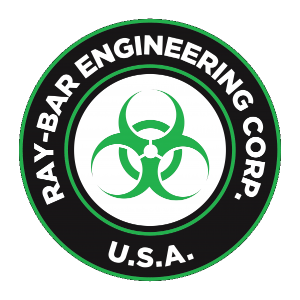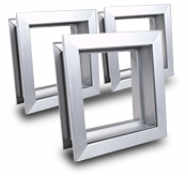
Antimicrobial Glass and Window Frames
Ray-Bar Engineering Corp is an uncompromising leader in the research, development, testing, design, and manufacturing of a wide range of advanced high quality/high performance, "state of the art", cutting edge life and safety protection products and materials. For over 75+ years our specialty is in clearly identifying a risk or threat, and then creating an innovative yet practical solution that is easy to utilize and integrate into various wall or partition systems either as new construction or into existing assemblies as a seamless retrofit application. Custom solutions to unique challenges are our daily focus in our design-consulting services for meeting current code requirements in a dynamic and ever-changing environment.
Addressing multiple threats with a single standard Ray-Bar product solution can be provided for radiation, fire, ballistic, blast, forced entry and many other threats.
In Ray-Bar's original field of providing Medical X-Ray Radiation Shielding, for both Diagnostic Imaging and also Cancer Radiation Therapy Treatment, we have identified 2 invisible life and safety exposure threats in the medical environment:
- X-Ray Gamma Ionizing Radiation utilized in the medical imaging processes
- Bacterial, Viral, and other contagious microbiological pathogens typically present in all medical offices, urgent care, healthcare, and hospital facilities.
Ray-Bar's various X-Ray Glass, Control Windows, Shielded Doors and Wall Panels for radiation shielding provide protection for the imaging technician and other medical personal from immediate and cumulative radiation exposure risks.
Medical Room Infection Risks
The infections that medical professionals inadvertently acquire while performing their duties are a very serious and common challenge. This can also include secondary infections that are contracted by patients due to contamination and exposure to pathogens during visits for medical treatment for other diseases or health conditions.
To make these serious matters worse, many of these invisible microscopic pathogens have mutated into "superbugs" that are resistant to most current antibiotic treatments. The terminology for these secondary infections to patients is "Healthcare-Associated Infections" or simply "HAI". HAI's are among the top 5 leading causes of death in the United States and are one of the most commonly prevalent and serious medical patient hazards. The annual numbers for total patient infections and mortality rates on certain pathogens such as Staph, MRSA, or C-Diff are increasing each year. Unfortunately the most susceptible and vulnerable to these infections are young children (under-developed immunity), older adults (declining immunity ) or people with underlying conditions or diseases (suppressed immunity), or patients receiving pharmaceutical drug treatments that suppress immunity for cancer therapy or to mitigate organ transplant rejection. Currently, it is estimated between 5% and up to 10% of all medical patients contract at least one or more hospital-acquired pathogen infection(s).
US Medical Infection Statistics
These medical infection exposure statistics are as reported by the Center for Disease Control and Prevention (CDC) as example just in the United States:
- It is estimated that of 300,000 annual Pneumonia (Clostridium Difficile) cases kill approximately 54,000 people each year
- It is estimated that of 120,000 annual MRSA (Methicillin-Resistant Staphylococcus aureus) Staph cases kill approximately 19,000 people each year.
- It is estimated that of 500,000 annual C-Diff (Clostridium Difficile) cases kill approximately 14,000 people each year
- It is estimated that of 55,000 annual VRE (Vancomycin-Resistant Enterococci ) cases kill approximately 5,400 people each year
- The National Nosocomial Infections Surveillance (NNIS) estimates there are 1,700,000 (1.7 Million) cases of HAI resulting in over 99,000 deaths annually in the United States.
- The annual costs of Healthcare-Associated Infections in hospitals, trauma centers, urgent care clinics, and other medical care facilities are estimated to be up to $45 billion annually.
The 4 typical ways of HAI pathogen transmissions typically occur are:
- Direct (human to human contact, such as a handshake)
- Indirect (Human contact with contaminated surface, touching any object)
- Droplets (Cough droplets: a typical cough projects 3,000 droplets at 50 miles per hour and spreads about 9 feet, and a sneeze spreads almost 40,000 droplets at 100 and up to 200 miles per hour spreading 50 feet. Each pathogen laden micro-droplets can have 100,000's of viral copies and stay suspended floating around airborne ranging from 10 minutes and up to 3 hours)
- Airborne (unseen bacteria or virus aerosolized in the air and then inhaled into a new host human)
*Outside of a medical environment some pathogens can be transmitted by a "Vector" carrier (I.E. mosquito transmits Zika or Malaria, or a rodent transmits the Black Plague).
Active Infection Control
Historically the only orthodox methods to reduce the transmission of these medical environmental infectious threats have been the established "active" infection control training and procedures including personal hygiene practices.
These active infection control procedures include but are not limited to:
- Hand washing and sanitation gels and soaps
- Personal Protection Equipment I.E. Face masks or respirators (N95), protective eyewear or face shields, Nitrile Hand Gloves, Tyvek "bunny" suits or "scrubs" gown.
- Continuous diligent cleaning, sanitizing and decontamination of medical equipment, x-ray imaging cassettes, furnishings, and surgical tools
- Continuous diligent cleaning, sanitizing and de-contamination of patient handling equipment such as wheelchairs, crutches, gurneys and exam tables
- Maintenance personnel thoroughly cleaning, disinfecting, sterilization and sanitizing of all surfaces: walls, windows, doors and floors.
Novel Corona Virus / COVID-19 / SARS CoV-2 Possible Applications
IMPORTANT NOTICE:
With the recently introduced and sudden global general public and medical practices health threat from the Novel Corona Virus (NCov) also known as COVID-19 (or SARS CoV-2) viral pathogen pandemic, the issue of secondary infections, contamination control, and Healthcare Acquired Infections is now more important than ever.
Although we can not yet claim that our products will inhibit the growth or colonization of the COVID-19 virus, our products are inherently easier to clean, sanitize and disinfect due to their treated or coated surface characteristics, so by default our products should reasonably be less of a indirect contact transmission source of disease/infection compared to other surfaces, when properly sanitized.
What is very unique to this viral health threat is its ability to remain viable on surfaces up to 9+ days, which makes indirect transmission and infection inherently more likely.
By comparison when exposed on a hard surface in open dry air typical influenza usually only lasts a few hours to a couple of days, and HIV just a few hours.
Additionally, our Ray-Bar x-ray protective radiation shielding glass, windows, barriers, wall panels, and door products are required for properly providing the required radiation shielding needed in protecting from gamma x-ray emissions from the X-Ray Imaging and C.T. Scans (Computerized Tomography) imaging required and the next step after the COVID-19 blood test diagnosis of this virus as X-Ray or CT Scan imaging accurately identifies the dramatic and unique severe lower respiratory pulmonary lung damage oftentimes caused by the COVID-19 virus shortly after the disease becomes symptomatic.
C-Arm and C.T. Scan radiation imaging are helpful and essential for accurate assessments in the diagnosis and prognosis of the COVID-19 virus.
See current COVID-19 CT Imaging reports Diagnosis and Prognosis evaluations and findings (RSNA)
These "active" procedures of personal protection, constant sanitizing, sterilizing and decontaminating work areas and equipment are very necessary for a comprehensive infection control program, however, they do not address an equally important "passive" static opportunity to supplement these "active" efforts by providing wall, door and window surfaces that resist pathogen growth and propagation and offer a quasi-clean room environment to all occupants including doctors, nurses, x-ray technicians, medical professionals, patients, and visitors.
*Side Note: There is no 100% pathogen free clean room
For the past year, Ray-Bar has been exclusively researching and developing long-lasting and effective "passive" antibacterial / antimicrobial treatments, coatings and additives of various product surfaces utilizing unique combinations of chemical-biological mechanisms and nano-technologies to disrupt pathogen growth, reproduction and colonization on our product surfaces as an option for all of our various medical construction-related materials and products lines as a static/passive way to reduce sources of indirect pathogen transmission and complement other conventional "active" efforts.
These Ray-Bar product integrated technologies are scientifically proven to measurably inhibit the growth of germs, bacteria, and other virulent pathogens, and/ or reduce adhesion to resist surface colonization or bio-film development as documented by qualified independent laboratory testing with protocols to established National or International standards.
Antimicrobial Product Solutions
Ray-Bar is proud to introduce the following antibacterial / antimicrobial options to all of our X-Ray Protection/ Radiation Shielding product lines listed below:
- Easy-Clean X-Ray Glass
- Telescopic X-Ray Window Frames
- X-Ray Control Barriers
- Shielded Hollow Metal Doors
- Pre-Finished Modular Retrofit Shielding Panels
As a result of the recent global corona virus outbreak we are increasingly being asked by customers about whether Ray-Bar's various antimicrobial technologies are
effective, specifically against the Novel Corona Virus also known as COVID-19.
Ray-Bar has extensive data on how our various "easy-clean" and other antimicrobial treated product surfaces options perform by utilizing bio-chemical or nano-technologies against either the adhesion, reproduction and/or surface colonization of bacteria and mold, however this is not the case for viruses.
Viruses are completely different from bacteria as they require living host cells in order to survive and replicate, whereas bacteria and mold can thrive independently. As a result of this difference, viruses are much more difficult to test , especially for open air environment solid surface testing.
Very specialized laboratories, protocol methods and equipment is needed, and the techniques utilize living cells in order to test for the presence of viruses.
It is only recently in 2019 that a standard testing method for antiviral properties of solid surfaces has been published.
When combined with the new and high risk status of the current corona virus strain, COVID-19, the additional procedures required to safely contain such a viral pathogen from release and possible contamination increases the difficulty in the handling processes and performing proper testing procedures against it
Our advice for anyone concerned about COVID-19 is to strongly encourage, aggressively support and enforce policies requiring regular washing and sanitizing , personal protection , housekeeping cleaning practices of work areas and a strong focus on employees personal hygiene, particularly hand sanitation.
It is advisable to require the following common sense infection control practices to reduce direct and indirect contamination and exposure including but no limited to:
Wearing face masks or disposable NIOSH approved respirators (N95, N99 or N100) and carry tissues to cover and contain any coughs or sneezes. Prompt disposal of soiled materials should be practiced, the area surfaces and any items should then be immediately sanitized and hands should be thoroughly washed.
Prioritize liberally and freqently washing hands with soap and water for at least 20 seconds, or use liquid hand sanitizers if there is no access to hand washing facilities.
Social distancing of at least 6'0" feet and wearing personal protection such as gloves, Tyvek suits and face masks/respirators is also prudent.
Additionally please carefully review and follow the guidance given by official government health authorities such as the CDC, Health Department, Infection Control or WHO.
Click on the links below for current official Corona Virus / COVID-19 Information and Updates
Federal Government Corona Virus Information
Center for Disease Control (CDC) Cornona Virus
U.S. Department of Health and Human Services
National Institutes for Health
U.S. Food and Drug Administration
*Also check with your local State health department for important updates specific to your area.
Contact Us to Learn How Ray-Bar Can Provide Antimicrobial Glass, Window Frames and Other Antimicrobial Products
For over 80 years, Ray-Bar Engineering has been a leading manufacturer of top-tier radiation shielding solutions for medical, hospital, and industrial NDT facilities worldwide. Our radiation protection shielding products are designed and manufactured with precision to meet the strictest U.S. and international radiation and building safety standards.
Contact us to learn how Ray-Bar's radiation shielding products can provide superior protection in your application. You can also request a quote online for pricing estimates on your project. For radiation shielding solutions that meet the highest industry standards, choose Ray-Bar Engineering.

